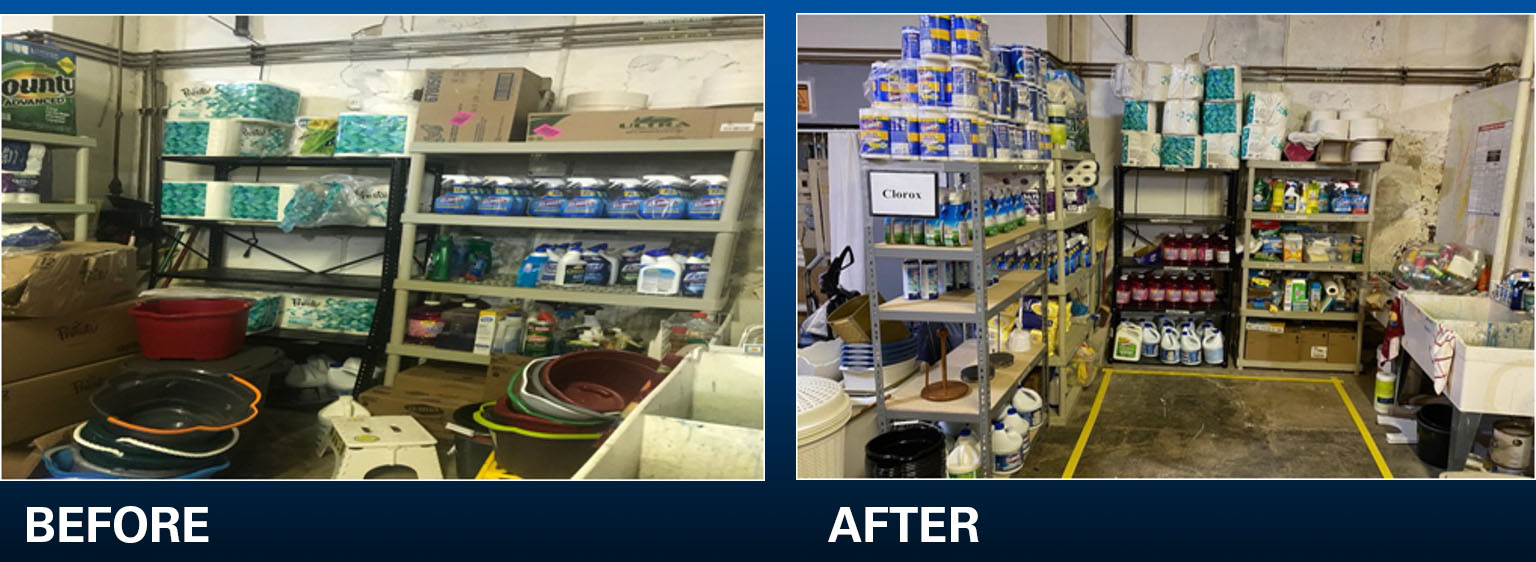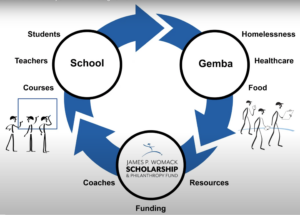
Humble Design Detroit furnished ten more homes in 2021 than it did in 2020, an increase that the community service organization previously couldn’t imagine. That’s according to Laura Corp, the nonprofit’s operations manager. And, she adds, the organization, which furnishes homes for individuals and families transitioning out of homelessness, doesn’t plan to stop there: It’s aiming to provide an additional 12 homes in 2022.
Corp credits the increase — and the mindset change that enabled it — to a partnership between Humble Design Detroit, the Lean Enterprise Institute’s James P. Womack Scholarship and Philanthropy Fund (JPW Fund), and Oakland University’s (OU) Pawley Lean Institute (PLI).
“Before we started partnering, reaching three houses per week was each Humble location’s goal, and there was never any thought about attempting to do more,” she says. “As our team began working with the OU students and learning about looking at the need that exists instead of our capacity, things began to shift.”
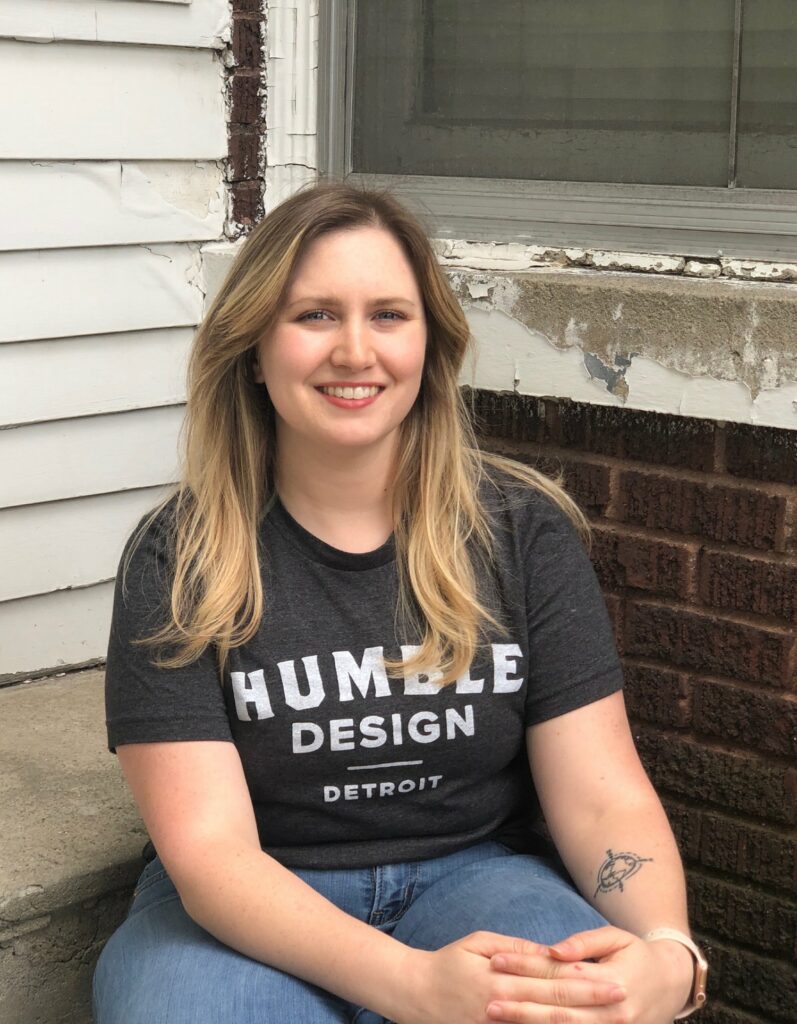
This change in mindset would not have been possible without the contributions you have all made, as well as the previous students we were able to work with.
Laura Corp, Operations Manager, Humble Design Detroit
“This change in mindset would not have been possible without the contributions you have all made, as well as the previous students we were able to work with,” Corp wrote in a letter to LEI President Josh Howell.
The partnership to which Corp refers is an internship program coordinated by the JPW Fund as part of its broader mission to facilitate research and creative learning experiences that advance lean thinking and practice. The program funds interns at schools teaching lean thinking and community service organizations willing to provide gemba-based learning and improvement opportunities. (See “Making the World Better by Advancing Lean Thinking and Practice.”)
Additionally, LEI supports the internships by supplying books and other learning materials and, when possible, recruiting an LEI coach from its extensive list of faculty to work with the interns and the nonprofit’s team in partnership with the interns’ academic coach/advisor. For the internship at Humble Design, for example, LEI Coaches Matt Zayko and Eric Ethington donated time, with Zayko coaching the first four teams and Ethington coaching the fifth. LEI’s goal with the internship program is to experiment with ways to end “rework” in the lean education process while improving society by teaching and encouraging more organizations to adopt lean thinking and practices.
Doing Well by Doing Good
The success of the internship program, the JPW Fund’s first foray into grantmaking, came despite the crippling effects of the pandemic, demonstrating its resilience. Now LEI, the Fund’s organizer, is reflecting on the program’s initial results to determine the next steps.
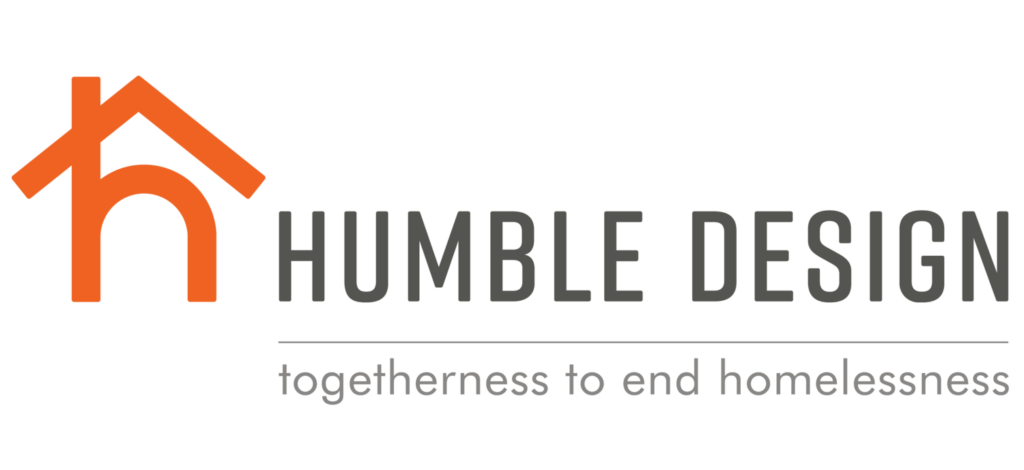
Since funding the first two interns in the Fall of 2019, the JPW fund has sponsored six successful student-intern teams from two university partners serving three community-service organizations — and it’s seeing meaningful benefits for all parties involved. In addition to the internships at Humble Design Detroit, the JPW Fund sponsored two Cal Poly interns’ Summer 2020 internships at Transitions-Mental Health Association (TMHA) in San Luis Obispo, California. TMHA is a commercial farm and nursery that offers job experiences to people struggling with mental illness. (See “A Philanthropic ‘Lean Internship’ Experiment Yields Unexpected Question About Purpose.”)
In an unexpected twist, the JPW Fund has also inspired other organizations to sponsor similar internships where students gain practical hands-on lean experience at community service organizations, helping improve their operations and, ultimately, serve more people. (See “JPW Fund Internship Inspires Others to Improve Lean Education,” below.)

Overall, 18 students (12 students under the JPW Fund) and four community service organizations are evidence that LEI’s experiment to find a way to end rework in the lean education process while improving the society-at-large is working.
In addition to Humble Design Detroit’s increase in the number of families they help, JPW Fund interns and their future employers also benefit. “The JPW Fund allows students to complete internships that add value to their resumes when looking for career opportunities,” Dennis Wade, the PLI executive director, says. “The value of lean, the community service internships, and the association with the JPW Fund is a differentiator when they interview for potential job opportunities.” The students also credit the practical experience gained from the internship for giving them an edge in the job market. Still, they say the more significant benefit was learning how to apply lean principles they learned in the classroom.
Monisha Vasudeva, part of the first team to apply the lean theory she learned in the classroom to address issues and innovate work processes at the Humble Design Detroit warehouse, notes that the internship helped her realize that “[lean] is not theory. Lean is something I have to work on based on what people right now are doing.” This lesson is one that lean practitioners will recognize as one that is difficult for mid-career professionals to understand.
Lean is not theory. Lean is something I have to work on based on what people right now are doing.
Monisha Vasudeva, JPW Fund Intern at Oakland University
Kaitlyn Trombly, who interned during the Winter 2021 semester, noted that “This opportunity not only gives students real hands-on experience but also teaches them lessons that they can use as reference for future endeavors.”
And, of course, the JPW Fund, with this first experiment, is demonstrating the value of introducing students to lean thinking and practice before they enter the workforce.
A ‘Humble’ Beginning
OU’s Pawley Lean Institute was the first academic program funded by the JPW Fund, choosing the Detroit location of Humble Design, established in 2009, as the first internship site. Humble Design Detroit already was working with an OU engineering professor to coordinate a student group project “to work with us on a much smaller scale,” Corp explained. But then, she “ended up connecting us to [the LEI internship program] to tackle some of the bigger problems.”
In a video about the first interns’ progress, Corp recalls that she and the professor had talked about how she and her team were “kind of just surviving, always putting out fires.” She says they discussed “the opportunities we’d have if we had people coming in to help us look at those problems and figure out different ways to address them and think about them.”
The original goal of partnering with OU and the JPW Fund, Corp adds, was merely to “switch our mindsets from surviving to being sustainable and calm.”
Getting Started
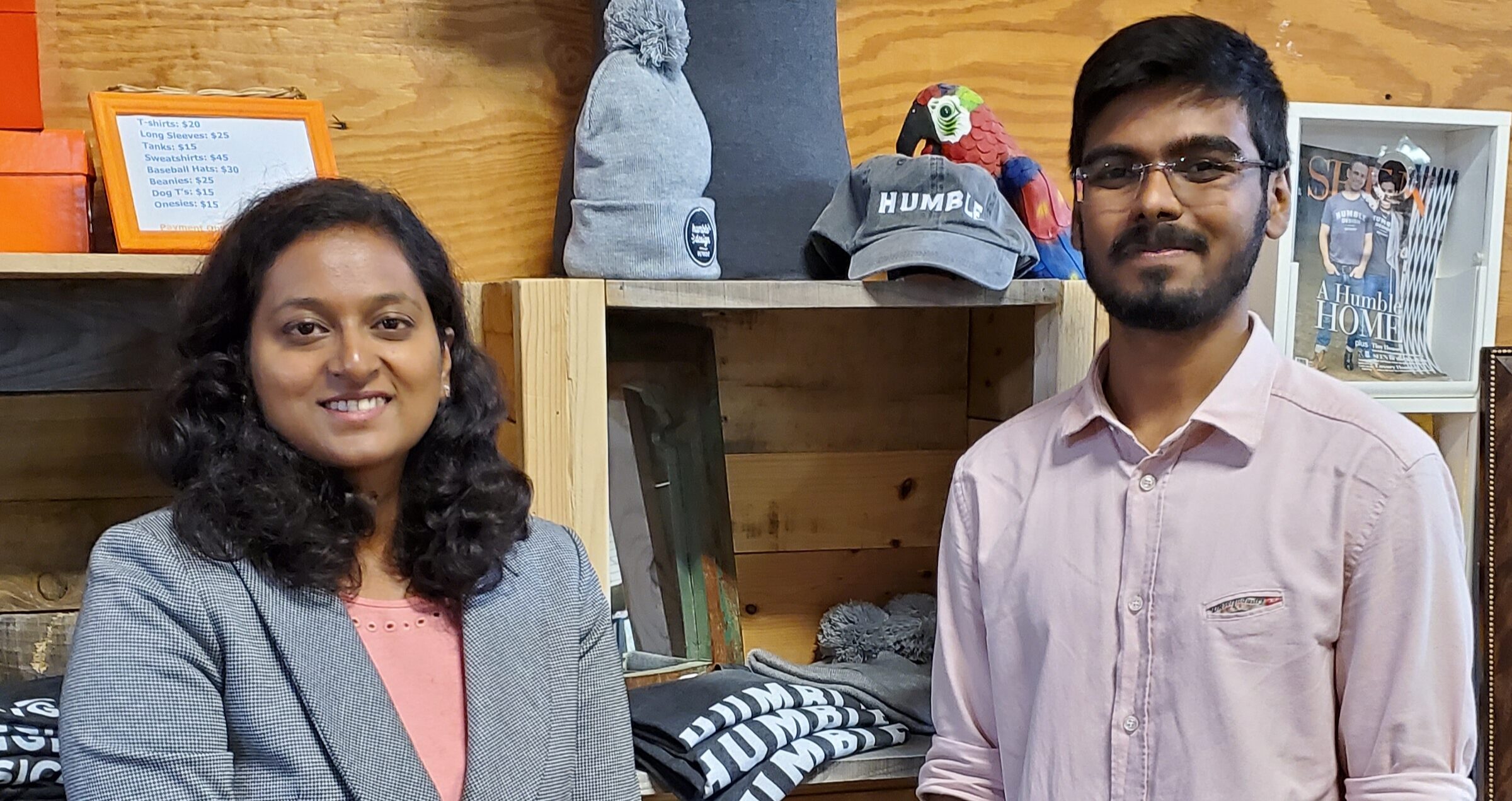
Vasudeva and Sagar Bajaj, who at the time were both candidates for a Master of Science in Industrial and System Engineering, received the first internship to optimize the space in the nonprofit’s warehouse. Their first actions, suggested by their coaches, LEI’s Matt Zayko and OU’s Bill Edwards, were to go to the gemba to learn more about Humble Design’s purpose and how the work supports it. For Humble Design, the work occurs in two locations: at the warehouse and at the homes when designers are setting up and helping people move in. So though the interns’ focus was on improving warehouse work processes, they participated in a housing setup and move-in reveal to understand what the organization does — and its impact on its clients.
When they toured the warehouse, they found it in a state of disarray that you might expect at a place primarily staffed by volunteers and where donations large and small arrive at irregular intervals from various sources. Also, they met a group of people — staff and volunteers — so focused on achieving their mission — fitting out houses for the homeless — that they felt they couldn’t spare any time to fix the problems that frustrated their efforts.
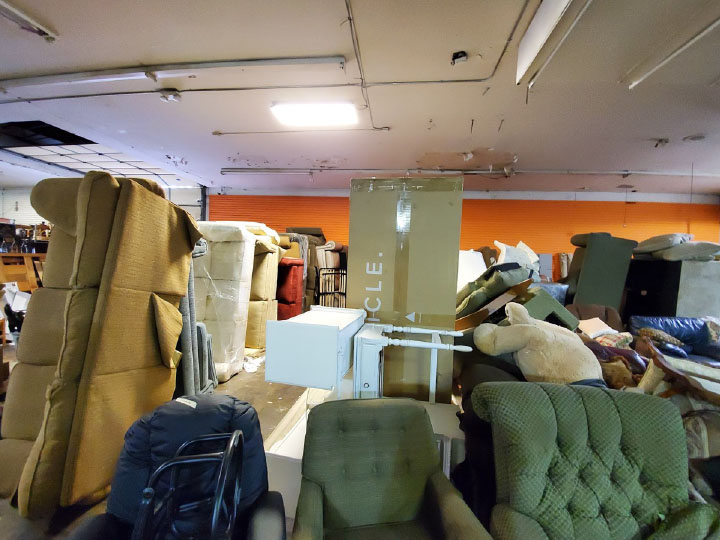
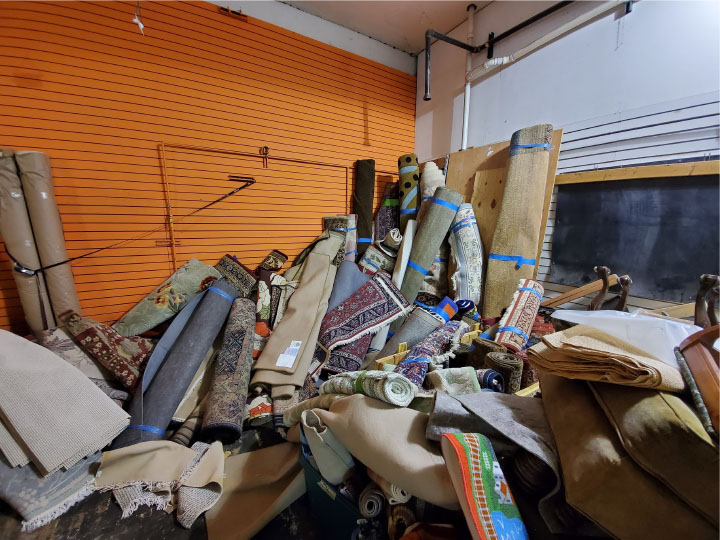
Though the warehouse had designated areas for different types of donations – sofas, bed frames, rugs, and the like — there was no standardized way to organize the types of items within each area, for example, by size and style. Also, most items lay in stacks and piles on the floor, spilling into aisleways; worn, unusable items mixed with nice things; rugs of different sizes, styles, and colors lay in mounds; chairs and tables were stacked precariously. In their “current state” observations, the interns noted that the disorganization made the warehouse unsafe and limited designers’ ability to select items efficiently.
Learning by Doing
Zayko and Edwards coached Vasudeva and Bajaj through using the A3 process they’d learned in the classroom to identify and prioritize what they could accomplish during the 10 weeks of their internship. Since the interns had learned the concepts through their coursework, “It was more important for us to help teach them the mental model” — the thinking involved, Zayko explains. For example, the interns first had to decide which of the many opportunities would be the most impactful for the organization and what they could accomplish in 10 weeks.

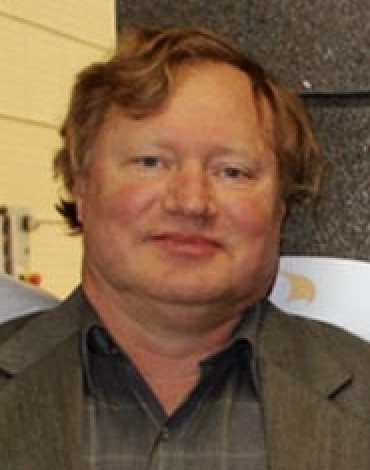
The interns narrowed their focus to a few areas through close observation, discussions with the staff, and coaching. They decided to target their efforts on improving overall warehouse safety and space utilization by organizing three areas, creating aisleways between rows of items to improve safety, and sorting the goods within each section by type. In addition to improving safety, they thought these changes would increase the visibility of donations, helping the designers to more easily find what they need as they fit out a home.
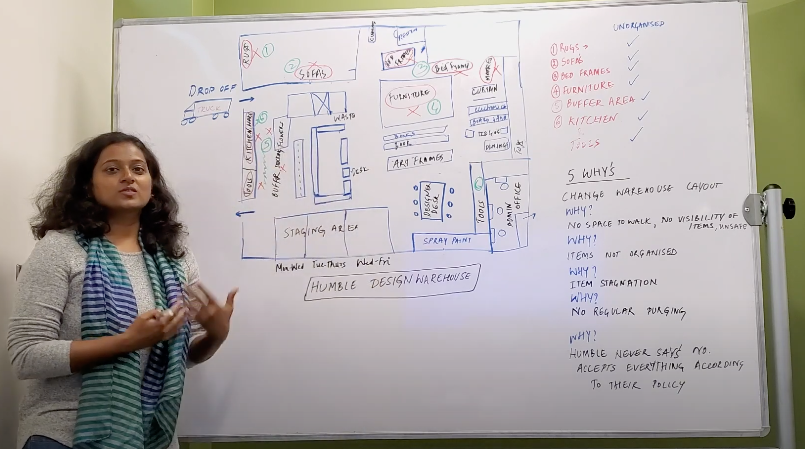
In addition to helping the students evolve their thinking as they used lean “tools” such as A3 problem-solving, mapping, and 5S, Zayko says he coached them through lean’s approach to managing change. “That’s probably one of the hardest parts about this, managing change,” Zayko adds. “You don’t realize how tough it is to get people to align on what the problems are until you try it.” It’s one thing to hear in a lecture that the A3 process is a way to gain agreement on the problem and how to resolve it by focusing on facts and collaborating with the people doing the work; it’s another thing to experience it.
This situation was another where the coaches emphasized “going to the gemba and seeing” to gain an in-depth understanding of the work processes. “We encouraged them to actually do the work [the volunteers do] and show respect — including when they would deliver the furniture and set up homes” rather than simply advising people how to do their work better, Zayko says. “That’s when you realize the work may seem mundane or repetitive but serves the bigger purpose.” So, figuring out how to safely store more donated items so designers can more quickly select items for a particular house is about helping Humble Design help more people.
We encouraged them to actually do the work [the volunteers do] and show respect …
Matt Zayko, Lean Coach, LEI
Another situation Zayko helped coach the interns through was the importance of checking and adjusting countermeasures that don’t work according to the plan. For example, the interns’ first idea for organizing the rugs was too expensive, forcing them to rethink their options.
Yet another lean experience was seeing the importance of teaching everyone to see and identify waste and problems to address. For example, Zayko describes how the interns noticed that a recycling bin for metals from broken, unusable items that a service retrieved weekly always filled up within a few days, leaving no place to put recyclable items, so things piled up. So, the interns suggested a solution that the busy staffers, not yet educated about identifying and tackling issues, overlooked: scheduling the service to empty the bin twice a week. This change had an immediate twofold impact: it reduced the clutter of items that they couldn’t put into a filled-up container and, since the service paid Humble Design for the metal, increased the money they made from recycling.
Tallying the Improvements
Among the most significant achievements, the interns improved safety in the warehouse by clearing pathways. They paid particular attention to the areas leading to the fire exit and electrical panels, clearly marking them with floor tape to visibly communicate that they must remain clear. They also reorganized the area designated for storing hygiene items, again clearing the floors to make the area safer and marking the aisleways to keep them clear. Finally, the interns identified an OU source to print and hang banners to visually indicate where specific items should go, setting the stage for written standardized work. They also installed shelving for tables and chairs and researched and identified shelving vendors for other areas.


After the first 10-week internship, with the interns dedicating 10 hours per week, the Humble Design staff noted significant improvements. “We had these racks installed, which has completely transformed our warehouse,” Corp said. “I think the biggest impact is that it’s much safer. We used to have chairs and tables stacked and then [stored] about three deep. Our warehouse manager was having to reach over, which isn’t good for your back, so installing these shelves has allowed us to become a much safer environment.”
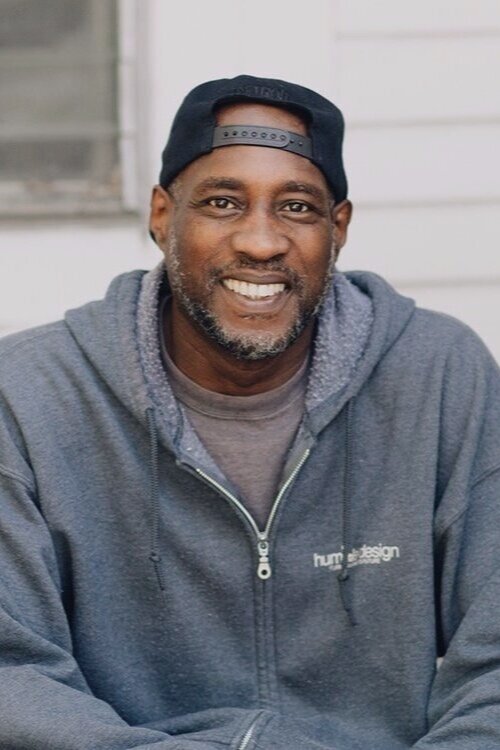
When I first heard about it, I said you guys are crazy, but as it got going, I love it
Carl Kyles, Warehouse Manager, Humble Design Detroit
Carl Kyles, Humble Design Detroit’s warehouse manager, concurs, “When I first heard about it, I said you guys are crazy, but as it got going, I love it,” he said. “You organized stuff, and that’s made it easier for me and the designers.”
Achieving Steady Progress
Over the subsequent four semesters, eight other interns working in pairs followed Vasudeva and Sagar, each team working with the staff to build on the improvements made by the previous one. (See “Internship Program’s Impact Grows Semester by Semester,” below.) Having interns demonstrating lean thinking and practice over those two and a half years helped the Humble Design staff see how ongoing day-to-day work making minor improvements over time makes a big impact.
| Internship Program’s Impact Grows Semester by Semester |
|---|
| Winter 2020 Vasudeva returned to Humble Design with Ansu John, a fellow student in the Industrial and Systems Engineering (ISE) program, to pick up where the first internship left off, working to improve warehouse operations. Their specific plan was to tackle two areas — rugs and chairs — created during the Fall 2019 internship. Then they worked with Corp, Kyles, and the volunteer designers to document standardized work for maintaining order while processing donated items. Despite the significant disruption caused by the pandemic, they achieved most of their goals. Though they identified a resource for racks to hold the rugs and chairs, they still needed to finalize the sizing for the rug racks and install additional chair racks, which they were unable to do because they couldn’t work on-site due to pandemic restrictions. Fall 2020 The following semester, Monica Elancheran and Natasha Hampshire, from OU’s ISE and Business programs, respectively, took the next steps to organize the rugs and tables while improving and creating standardized work for overall inventory management. Their goals were to help staff and volunteers more easily track the amount of inventory and locate it when designing décor for a home. Though they reorganized the tables, the interns found that the cost of the rug racks exceeded the budget. So, after brainstorming other options, they designed a rug storage structure to be built, which included a labeling system and standard work for organizing them by size, color, and style (e.g., floral, vintage, modern, etc.). Winter 2021 In the Winter 2021 semester, Kaitlyn Trombley, a business major, and Noah Redoute, an engineering student, worked toward improving workflow throughout the warehouse and helping volunteers select and complete tasks independently. To achieve this goal, the interns printed signs to indicate where each type of donation goes and created visual standardized work instruction cards that detail how to do various tasks within each area. Then, they placed the “task cards” where the volunteers do the work and included copies of each in a reference binder for Corp and other staff members. They also printed and posted laminated signs to remind volunteers of safety protocols and created a kanban board where the volunteers can select from the day’s tasks, indicating that they are in progress or completed. Fall 2021 Finally, in the Fall of 2021, Carly Kallen and Lauren Woolford, both from the ISE program, tackled organizing a warehouse Humble Design Detroit operated as part of a partnership with U-Haul, seeking to free up space in the main warehouse. Building on the work previous interns completed in the main warehouse, they created a storage layout, optimizing it to make it easier to move furniture into and out of the building. The work involved interviewing designers to learn more about their needs and then determining which items to move from the main warehouse to the U-Haul space. Additionally, they completed the first three steps of 5S implementation (sort, set in order, and shine) at the site. The team improved mattress/box springs inventory tracking, increased access and visibility of most items, established locations (visually indicated with signs) for where to unload incoming donations, discarded unusable furniture, and freed up floor space to meet U-Haul’s regulations. |
This lesson, according to Corp, was a significant takeaway for the small team with little time to complete big projects. “It’s been important that we’ve [had JPW Fund interns] for more than one semester, to keep building little by little and, at the same time, hoping that when this ends, that we have learned enough to keep going on our own,” she says. “We’re slowly getting better at not starting something really ambitious and then letting it die off, which has been a continual problem,” she says, noting that the staff members have started doing improvement projects without the interns’ help. She describes how the staff recently installed additional shelving in the chair section as an example. “It’s not that we didn’t want to do these things before, but we never made it a priority, because it just seemed overwhelming.”
Growing the Impact
Though the pandemic interrupted the original JPW Fund growth plans, the LEI board is pleased with the results of these initial experiments. OU and Cal Poly’s internship programs demonstrate the many benefits of reducing the rework in lean education: The students gain hands-on experience practicing lean. The nonprofit organization staff learns along with the interns while leveraging the improvements to help more people. Potential employers who hire the JPW Fund interns get employees who can work the lean way from day one.
With these results and the challenges from the pandemic receding, the board is eager to begin planning how to build the program through fundraising and educational partner recruitment. In the meantime, the board continues this internship partnership with the OU-Pawley Lean Institute and plans to work with Cal Poly to explore how it could offer perhaps a second internship.
Though Matt Lovejoy, who, as an LEI board member, led the team creating the internship program, no longer oversees the internship program, he’s still a strong supporter. He continues to donate through his company, Lovejoy Industries, Northbrook, Illinois, and attends most student report-outs.
“LEI has been on a mission for 25 years, trying to spread the word about lean, trying to improve the world through lean concepts and principles,” Lovejoy declares. “That mission needs to continue because lean works, and the more people we enlighten and the more people we get into this way of thinking, the better off we’ll be.”
The internship “kind of lit a fire under us and then helped us figure out what we need to do to have a more efficient and mainly safer warehouse,
Laura Corp., Operations Manager, Humble Design Detroit
Humble Design Detroit’s experience bears out Lovejoy’s assertion. The internship “kind of lit a fire under us and then helped us figure out what we need to do to have a more efficient and mainly safer warehouse,” Corp said. “I think that we have learned a lot, and all of us as a team are slowly learning to think this way.”
| JPW Fund Internship Inspires Others to Improve Lean Education |
|---|
| Reports of the first successful PLI-JPW partnership at Humble Design led to an unexpected boost to OU’s PLI internship offerings — lean practitioners at a nearby Jabil plant contacted OU to see how they could participate. In the early phases, the representatives’ contribution was to help build and install the shelves that the interns had suggested as a countermeasure to cluttered aisleways. Later, Jabil representatives offered coaching and mentorship, funded projects, and donated time to build and install student-designed storage — support needed to help the interns implement the work process improvements they’ve identified. For the Winter 2021 semester, AT&T Michigan, based in Detroit, and Jabil in Auburn, Hills, Michigan, teamed up with PLI to sponsor an internship at Fleece & Thank You, based in Farmington Hills, Michigan. The nonprofit offers “comfort and connection” to children facing extended hospital stays. The group coordinates the delivery of fleece blankets and a personal video message from the blanket maker to recipients, who then can send a thank-you message to the maker. The following fall, 2021, Bosch Community Fund, Farmington Hills, stepped up to sponsor the second internship at Fleece & Thank You, focusing on improving quality. Finally, for Winter 2022, AIC-PlastiCo Equipment, Wixom, Michigan, and Jabil joined forces, sponsoring an internship at Fleece & Thank You that targeted improvements in inventory tracking. The LEI Board applauds these organizations for taking up the challenge of helping to solve the “rework” problem in lean education. |
Managing to Learn with the A3 Process
Learn how to solve problems and develop problem solvers.
